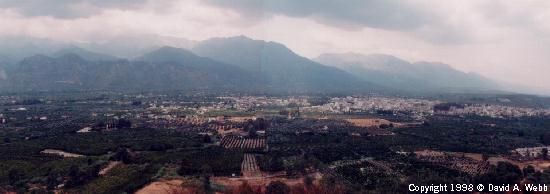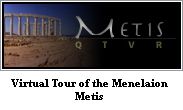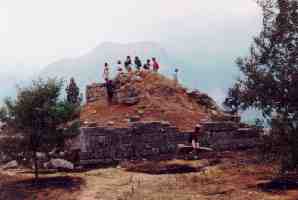


The site Pausanias dubbed Therapne is well known in Sparta today as the Menelaion: the shrine of Helen and Menelaos. The picturesque archaic mound topped by a shrine is actually not the most significant archaeological site there though. A few meters away are the remains of the earliest Mycenaean "Palace" in mainland Greece.
The Bronze Age Site
 The Menelaion was not among the first sites to be occupied in prehistoric
Sparta. Other sites in the valley had been inhabited from Neolithic times
and a number of other sites have shown evidence of Early Helladic (c. 3000-2000
BCE) settlements. But the finds at the Menelaion have shown that
it eventually became the most important site in the region. At the
same time the early rich burials were being made at Mycenae, c. 1700
BCE, dwellings with stone walls began to be built on the Menelaion
hill and on the large hill about 100m. north of the site. Burials
were also found that date to this level. Pottery fragments show that
there was continuous settlement here in the late 16th and 15th centuries,
and some monumental building was probably constructed during this time,
evidenced by later re-used blocks. It was at this time when other
fine pottery styles show that the site was already important.
The Menelaion was not among the first sites to be occupied in prehistoric
Sparta. Other sites in the valley had been inhabited from Neolithic times
and a number of other sites have shown evidence of Early Helladic (c. 3000-2000
BCE) settlements. But the finds at the Menelaion have shown that
it eventually became the most important site in the region. At the
same time the early rich burials were being made at Mycenae, c. 1700
BCE, dwellings with stone walls began to be built on the Menelaion
hill and on the large hill about 100m. north of the site. Burials
were also found that date to this level. Pottery fragments show that
there was continuous settlement here in the late 16th and 15th centuries,
and some monumental building was probably constructed during this time,
evidenced by later re-used blocks. It was at this time when other
fine pottery styles show that the site was already important.
The Mycenaean Mansions
In the second half of the 15th century,
a large building, characterized as a "mansion" was constructed on the site.
"Mansion 1" had two storeys, a megaron-type core, and a southern face that
has been eroded away. Some rooms had plastered walls and the carefully
laid pebble floors still exist. Relatively soon after it was constructed,
Mansion 1 was most likely hit by a devastating earthquake that levelled
the building. Mansion 2 was built on the same site as the previous
one but it faced west instead of south. The second construction also
built over the demolished walls of Mansion 1 in order to make the newer
building more stable. The building was not occupied for a space of
about a hundred years (during the 14th and 13th centuries) and then the
building, partly in ruins, was again refurbished. This repaired construction
is called Mansion 3. At this time, another two-storeyed building
was constructed on the large hill about 200m south of the site - also known
as Aetos Hill. The entire complex was destroyed by fire in the 13th
century BCE, around the same time that the palace at Pylos was consumed.
Three human skeletons found in 1974 possibly date to this final destruction.
No Linear B tablets have been found here like the site at Pylos, but a
painted inscription has been found on a storage jar.
 Though much attention has been focused during excavations on finding some
type of continuity between the Mycenaean levels and the shrine, no solid
evidence has yet been found. Dedications have been found that name
both Helen and Menelaos. Though there are now two divergent theories
on the appearance of the shrine in 8th century BCE, the usually accepted
one involves a hero-cult being created at the site as a possible result
of the still visible signs of the mansions which may have been identified
by the archaic Spartans as the home of their Mycenaean hero. Another
possiblity exists that the site was originally sacred to the early vegetation
goddess Helen, and only later appropriated by Helen and Menelaos.
The difference would be whether or not the structure was a temple for a
divine cult or a tomb-shrine (tomb or not) for a hero cult.
Though much attention has been focused during excavations on finding some
type of continuity between the Mycenaean levels and the shrine, no solid
evidence has yet been found. Dedications have been found that name
both Helen and Menelaos. Though there are now two divergent theories
on the appearance of the shrine in 8th century BCE, the usually accepted
one involves a hero-cult being created at the site as a possible result
of the still visible signs of the mansions which may have been identified
by the archaic Spartans as the home of their Mycenaean hero. Another
possiblity exists that the site was originally sacred to the early vegetation
goddess Helen, and only later appropriated by Helen and Menelaos.
The difference would be whether or not the structure was a temple for a
divine cult or a tomb-shrine (tomb or not) for a hero cult.
In the shrine's earliest form, there
may not have been a structure at all. A rich deposit of offerings
from the late 8th and early 7th century were found NE of the later shrine.
In the late 7th century, a monumental structure was constructed at the
site of the shrine. This Old Menelaion appears to be the earliest
evidence of monumental building in Laconia above foundation level.
In the Hellenistic period, the Menelaion
stood in ruins, maybe as the result of an earthquake. During the
Roman period there were no reconstructions or repairs at the site.
Pausanias did not think it worth his time to visit the site.
The Menelaion was one of the first sites to attract the attention of European
visitors travelling through Sparta.
The Modern Site
To reach the Menelaion, you must first
cross back over the Eurotas River NE of town. Then turn right onto
the Yeraki road and after about 4.5 km, take a small path to the left that
leads to the chapel of Agios Ilias. The path was recently paved with
concrete as far as the chapel, and small cars can probably make it this
far. You continue walking up the path to get to the Menelaion (about
12 more minutes of walking, but with rewarding vistas).
There is no phylax at the site, though
a small chapel does sit nearby. The view from the Menelaion, in my
opinion, is one of the best in all of Greece. It sits high above
the Eurotas valley and commands one of the best views of the Taigetos that
you can find. The photo at top was taken at the site, looking back
over the valley to the west - absolutely spectacular. The platforms
which compose the shrine are conspicuous and, with the mountains in the
background, make for a truly amazing photograph (see the cover of the book
Filolakon:
Laknoian Studies in Honour of Hector Catling). The remains of
the Mycenaean "mansions" are also well preserved and not covered over.
In the summer of 1998, we visited
the site literally hours after a large forest fire had destroyed much of
the surrounding vegitation. Olive trees cover the hillsides and many
were lost, though around the site itself a number escaped damage.
The ground was blackened all the way up to the shrine and many places were
still actually smoking while we were there! Regardless, it was still
a terrific experience and one not to be missed even though it is a few
kilometers outside of the city.
I would also like to thank Kasia Hagemajer
for her presentation at the Menelaion (July 1998) and for the bibliography
on the site.
Modern Sources
Antonaccio,
C. 1995. An Archaeology of Ancestors: Tomb Cult and Hero-Cult in Early
Greece. Lanham, Md. (Buy this book now!)
Barber,
R.L.N. 1992. "The Origins of the Mycenaean Palace." in Philolakon: Lakonian
Studies in honour of Hector Catling, ed. Jan M. Sanders: pp.
11-23. (Buy this book now!)
Catling, H.W. "Excavations at the
Menelaion, Sparta, 1973-6." Archaeological Reports 23 (1976-7):
24-42, (1980-1): 16-19.
--. 1993. "Sparta: A Mycenaean
Palace and a Shrine to Menelaos and Helen." Current Archaeology
130: 429-31.
Catling,
R.W.V. 1992. "A Votive Deposit of Seventh-Century Pottery from the Menelaion."
in Philolakon: Lakonian Studies in Honour of Hector Catling, ed.
Jan M. Sanders: pp. 57-76. (Buy this book now!)
Coldstream, J.N. 1976. "Hero-cults
in the Age of Homer." JHS 96: 8-17.
Farnell, L.R. 1921. Greek Hero
Cults and Ideas of Immortality. Oxford.
Hagg, R. 1987. "Gifts to the Heroes
in Geometric and Archaic Greece." T. Linders and G. Nordquist, eds. Gifts
to the Gods. Uppsala: 93-99.
Malkin,
I. 1994. Myth and Territory in the Spartan Mediterranean.
Cambridge. (Buy this book now!)
Morris, I. 1988. "Tomb Cult and 'Greek
Renaissance': The Past and Present in the 8th c. B.C." Antiquity
62: 750-61.
Polignac,
F. de. 1995. Cults, Territory and the Origins of the Greek City-State.
Chicago. (Buy this book now!)
Snodgrass, A.M. 1982. "Les origines
du culte des heros in Grece antique." G. Gnoli and J.P. Vernant, eds. La
mort, les morts, dans les societies anciennes. Cambridge: 107-119.
Stibbe, C.M. 1996. Das Andere
Sparta: Aus dem Niederlandischen von Herbert Post. Mainz: 41-49.
Tomlinson,
R.A. 1992. "The Menelaion and Spartan Architecture," in Philolakon:
Lakonian Studies in Honour of Hector Catling, ed. Jan M. Sanders: pp. 247-256.
(Buy this book now!)
Wace, A.J.B., et al. 1909. "The Menelaion."
BSA 15: 108-157.
Whitley, J. 1988. "Early states and
hero-cults: a reappraisal." JHS 108: 1-9.
Links: